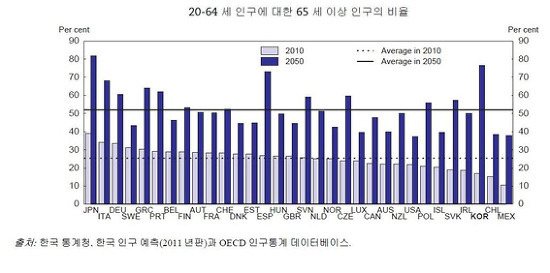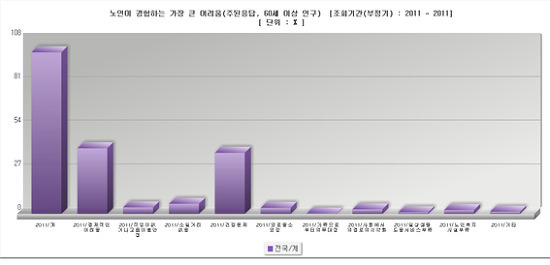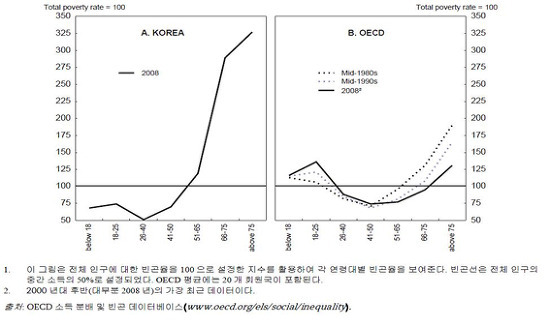No. 1 among
Organization for Economic Cooperation and
Development (OECD) countries.
No.1 in aging population, No.1 in
elderly poverty rate, No.1 in elderly suicide rate
By Jiyeon Shin, Voluntary Activist
We are only in the beginning of the New Year but “Dying
alone”, “Korean working population’s average age will be 50 in 2045” and
“elderly suicide rate” are the news shown by TV. It is a gloomy news that the
elderly population will exceed the working population in 30 years and the
potential growth rate will decline within 10 years.
The ratio of aging population
in Korea was already 24.46% in Fall 1995 which exceeds the world average of
19.1%. After becoming an aging society in 2000, the reported figures were 41.3% in
2003, 44.1% in 2004, 47.3% in 2005, 51.0% in 2006, 55.1% in 2007, 59.3% in
2008, 63.6% in 2009, 67.7% in 2010, 72.4% in 2011 and 77.7% in 2012 and
moreover, Korea is predicted to become an aged society by 2019 and super-aging
society by 2026. On the contrary to Japan which is expected to take 36 years to
become a super-aging society, Korea is expected to take approximately 27 years.

The problem of the elderly suicide rate is even severe. Such
an unexpected figure motivated me to write this article. Donghyeon Kim, a
professor at the Social Medicine Department of Hallym University College of
Medicine, pointed out the problem through Hankyorae newspaper as below.
“In other countries, the
suicide rate is high in 10~30s which usually decreases when they become old. If
it increases, it only increases slightly. However, the suicide rate of Korea
constantly increases from teens and when the age reaches 65 the increase rate
becomes so high that the rate is not even comparable to other age groups. In
the age group between 10s and 30s, the suicide rate is lower than Norway and Italia.
In other countries, the suicide rate after 60s is 20~40 per 100,000 people.
However, it far exceeds 100 in Korea. After the age of 75, it even exceeds 160.
Japan, our neighbor country, shows a peak in the suicide rate among the mid 40s
but the rate decreases afterwards. This shows that Korea has reached an
unbeatable position in the field of the elderly suicide.”
What are the causes of such a high
elderly suicide rate? The first is poverty and there can also be others such as
conflict in family, loneliness, poor measures of the government and diseases
such as depression, cancer and dementia.


Currently Korea is under a very severe condition that the
half of elderly population is poor and the elderly poverty rate amounts to
45.1, which is three times the OECD average of 13.5.

The Ministry of Health and Welfare legislated laws for the
welfare of the elderly in 2007 in order to enhance their health and welfare.
The Ministry is making effort to establish and operate specialized institutions
for creating jobs for seniors, support professions, promote elderly discount,
support old people living alone and establish welfare organizations for the
elderly. But it is doubtful whether the political and administrative support of
the nation and local governments are meeting the required standard.
The dependent
senior population is increasing while economically active people are decreasing
in accordance with the trend of low birth rate and aging population which
results in a rapid increase in the sustenance allowance and medical expenses of
seniors. This also becomes a burden to the next generation. Thus, supporting
old people should be understood as a shared responsibility of the country,
society and family. The government has been reluctant to enhance the welfare
probably due to the impediment of the economic development and increase in the
tax burden.
Park Geun-hye, a
president-elect, said “It is an obvious responsibility of the nation to
guarantee happy lives of the elderly.” and emphasized that “the country will do
its best”. “As Korea entered the aging society, how to spend the time happy and
satisfactory at old ages has become a national task”. She continued “the
foundation of policies is to support the elderly to live comfortably without worries”
and suggested elderly welfare policies such as △ introduction of basic pension △ Increase in job opportunities △ 100% financial support on 4 serious
illness △ Reduction on implant expenses △ Provision of long-term care insurance
for seniors with dementia and physical disabilities △ Provision of long term care insurance
for seniors living alone and the disabled in the second highest level
It is likely that quite a
number of people over 50 actively supported Park because of these types of
dream-like-policies. It is true that only looking at these policies make us
think South Korea can be a country for the elderly. From now on, we should keep
our eyes on how the Park’s welfare of the elderly is realized and what kinds of
policies are prepared for the poor seniors.
We hope
user-centered-welfare policies are carried out for the elderly and the dishonor
of being No.1 in aging population, elderly poverty rate and suicide
rate to be removed.
Attached files are the data
provided by Statistics Korea.
 노인(65세_이상)의_일반특성별_자살생각_이유_및_시도_(연도).xls
노인(65세_이상)의_일반특성별_자살생각_이유_및_시도_(연도).xls
 노인이_경험하는_가장_큰_어려움(주된응답,_60세_이상_인구).xls
노인이_경험하는_가장_큰_어려움(주된응답,_60세_이상_인구).xls